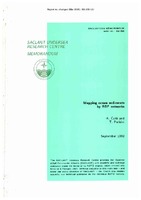| dc.contributor.author | Caiti, Andrea | |
| dc.contributor.author | Parisini, T. | |
| dc.date.accessioned | 2018-10-11T14:06:12Z | |
| dc.date.available | 2018-10-11T14:06:12Z | |
| dc.date.issued | 1992/09 | |
| dc.identifier | 1738 | |
| dc.identifier.govdoc | SM-256 | |
| dc.identifier.uri | http://hdl.handle.net/20.500.12489/209 | |
| dc.description.abstract | Interpolation of sparse measurements of ocean-sediment properties by generalized radial basis function (RBF) networks is proposed. An RBF | |
| dc.description.abstract | network is able to generate a continuous smooth approximation for sediment properties as a function of the x-y-z position, where z is the sediment depth. Advantages and disadvantages of the method are discussed, from both a physical and a computational viewpoint. An example using sediment density data obtained by sparse core measurements in a region of the Mediterranean Sea is presented. | |
| dc.format | vi, 13 p. : ill. ; 6 fig. | |
| dc.language | English | |
| dc.publisher | NATO. SACLANTCEN | |
| dc.relation.ispartofseries | ADB178302 | |
| dc.subject | Seafloor sediments | |
| dc.subject | Neural networks | |
| dc.subject | Mediterranean Sea | |
| dc.title | Mapping ocean sediments by RBF networks | |
| dc.type | Scientific Memorandum (SM) | |
